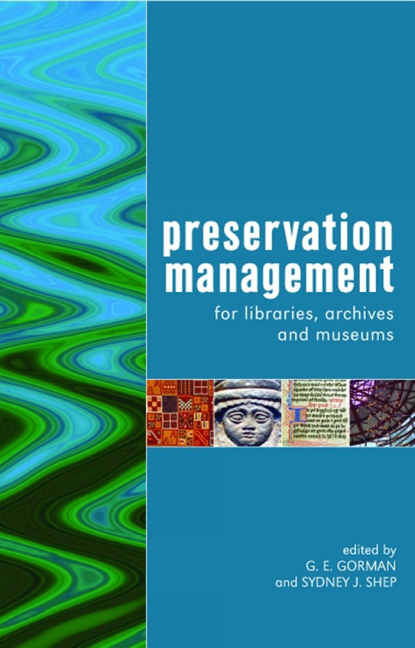Book contents
- Frontmatter
- Contents
- About the contributors
- Introduction
- 1 Managing the documentary heritage: issues for the present and future
- 2 Preservation policy and planning
- 3 Intangible heritage: museums and preservation
- 4 Surrogacy and the artefact
- 5 Moving with the times in search of permanence
- 6 Valuation model for paper conservation research: a new approach for setting research priorities
- 7 Preservation of audiovisual media: traditional to interactive formats
- 8 Challenges of managing the digitally born artefact
- 9 Preserving cultural heritage in times of conflict
- 10 Access and the social contract in memory institutions
- 11 Redefining ‘the collection’ in the 21st century
- Index
8 - Challenges of managing the digitally born artefact
Published online by Cambridge University Press: 08 June 2018
- Frontmatter
- Contents
- About the contributors
- Introduction
- 1 Managing the documentary heritage: issues for the present and future
- 2 Preservation policy and planning
- 3 Intangible heritage: museums and preservation
- 4 Surrogacy and the artefact
- 5 Moving with the times in search of permanence
- 6 Valuation model for paper conservation research: a new approach for setting research priorities
- 7 Preservation of audiovisual media: traditional to interactive formats
- 8 Challenges of managing the digitally born artefact
- 9 Preserving cultural heritage in times of conflict
- 10 Access and the social contract in memory institutions
- 11 Redefining ‘the collection’ in the 21st century
- Index
Summary
Introduction
This chapter examines the challenges of managing digitally born artefacts. It raises more questions and issues than provides answers. A large body of international research is being undertaken both within and across information disciplines in digital preservation. A growing body of practical experience is emerging. At this time the conclusions are that no one ‘solution’ exists to the challenges in digital preservation and that multiple strategies should be pursued with equal vigour. This conclusion is not intended to encourage information professionals to adopt a wait and see strategy, for digital resources are fragile, vulnerable and in need of constant attention in order to exist in both the short term and long term. No cultural heritage institution can afford to postpone the challenges of managing the digitally born artefact.
Why are digitally born artefacts different?
Chapter 4 has addressed issues of surrogacy and the artefact. This chapter is dealing with those artefacts whose initial and continuing manifestation is as a digital resource, rather than those whose format was altered to a digital manifestation. There is a cross-over relationship between these two broad categories of resource. Once something has been rendered digital, the preservation challenges to maintain that object in its new form coincide with the challenges of the digitally born. However, the challenges are simpler. Not only is there the potential safeguard that the artefact may exist in its original format, but by implication the artefact reformatted will already exist in a controlled environment and have been subject to the controls of a formal institution (Lynch, 2004, 610). No such safeguards, real or implicit, can be assumed to exist for the mass of digitally born material.
The vast majority of original information being produced is in digital format. Estimates of quantity in 2003 indicate five exabytes (or 1018 bytes) of new information was produced in 2002, with over 92% of this stored on magnetic media, primarily hard disk. This represents a growth of about 30% per year between 1999 and 2002. The largest area of growth is in the area of office documents. The world wide web is estimated to contain 167 terabytes of information on the surface web with more than 400 times this amount on the deep web (that part of the web driven by databases that create web pages on demand (OCLC, 2004).
- Type
- Chapter
- Information
- Preservation Management for Libraries, Archives and Museums , pp. 117 - 132Publisher: FacetPrint publication year: 2006
- 6
- Cited by

